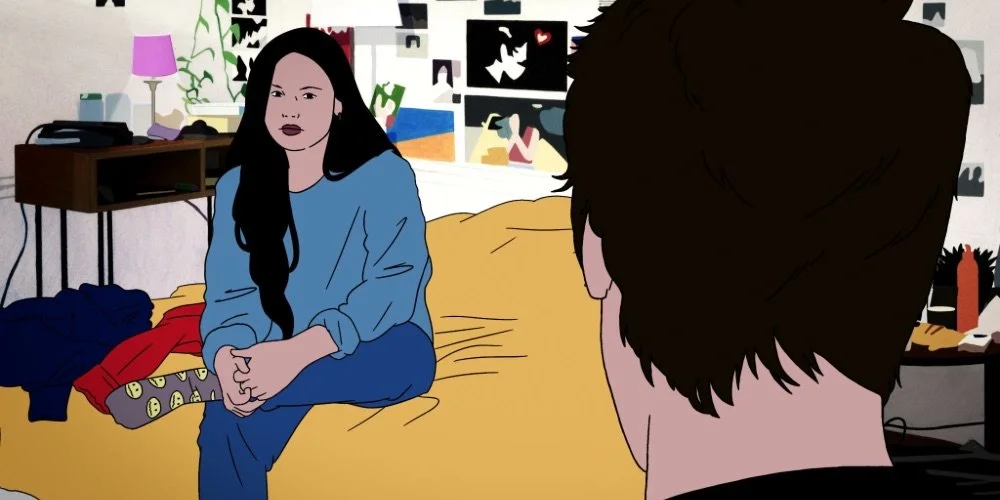‘Coma’ Review: Disintegration Gives Way to Regeneration in Bertrand Bonello’s Covid-Era Experiment
Courtesy of Film Movement.
Over the past four years, many films and television shows have utilized a global pandemic as their backdrop, using the existential concerns brought up by such a familiar crisis to varying degrees of success and significance. In 2024, it is safe to assume that many audiences have grown weary of these portrayals, sapped by the collective trauma of a not-so-distant period that has shaped our everyday lives in ways that we have yet to understand fully. In the stasis necessitated by pandemic-era lockdowns circa 2020, French filmmaker Bertrand Bonello conceived Coma, arguably the trimmest yet most explorative work of his nearly three-decade career. Coma was informed by a letter the director wrote to his daughter Anna, who turned eighteen during the beginning of the pandemic, funneling Bonello’s uncertainty for Anna’s future into an undefinable work that examines the indomitable forces of the modern world and the way they could shape future generations. Through its heady concepts and amorphous structure, Coma serves as one of the most intriguing examples of COVID-era filmmaking.
Coma focuses its gaze upon an unnamed girl (Louise Labèque, star of Bonello’s 2019 feature Zombi Child) whose entrance into adulthood coincides with an unspecified pandemic that has forced isolation lockdowns worldwide. The girl spends her days alone in her bedroom: envisioning melodramatic showdowns between her dolls, talking with friends via Zoom calls, and becoming increasingly obsessed with a bizarre internet personality named Patricia Coma. Enigmatic and moody, Patricia (Julia Faure) helms a YouTube channel dedicated to a cryptic sort of wellness, “a channel to help you live better.” Feeling increasingly lost in her lonely world, the girl enters the liminal space between dreams and reality, unable to grasp a semblance of her own existence as she delves deeper into Patricia’s instructions.
Courtesy of Film Movement.
Completing Bonello’s “Youth Trilogy,” Coma bypasses the genre elements of its predecessors Nocturama and Zombi Child in favor of a contemplative, future-fixated tone that aligns itself much more clearly with the director’s recently released The Beast. Bonello’s existential concerns for coming generations are undoubtedly tied to the COVID times in which the movie was conceived, but still intensely resonate with the state of our world, contributing to the film’s most thoughtful dimensions and its value for audiences today. Filmed over just twelve days, Coma’s budget and shooting limitations seem to liberate the work from the plotted trappings found in the director’s earlier movies, its elliptical storytelling working in connection with the film’s increasingly surreal and disorienting elements. Coma singularly combines feelings of ennui and isolation with slashes of gnarled violence, creating an unsettling experience that will likely stay with viewers long after they have left the movie theater.
Coma portrays its young protagonist and the constraints of her world with a particular grief, a mourning for those coming of age in a disconnected world. The girl is inundated with Patricia's YouTube convictions about the modern world and its lack of free choice, which seem more convincing as the film captures the restrictions and surveillance that force the girl into seclusion. In relation to youth's dependence on technology today, screens act as both the connection and barrier to the girl's outside world, as she endlessly broods over emotions and relationships with others that her circumstances only allow her to fantasize about. Perverse media spectacles weave in and out of the girl's conscious thinking, captured through the Donald Trump tweets that inspire the dialogues she constructs for her dolls and the Zoom club she has created with her friends in honor of history's most charismatic serial killers. Paternal anxiety is clearly illustrated through these depictions of contemporary youthhood, adding an emotional charge to Bonello's filmmaking and deepening the complex assertions he puts forth in Coma.
The experimentation of Coma's narrative structure is supported by Bonello's inventive craft employed in the movie. Initially conceived as a standalone short film, Coma's prologue is a series of pixilated images overlayed with the film's inspiration: lines from the letter he wrote to his daughter for her eighteenth birthday. From these disorienting frames, the movie goes on to utilize a mix of mediums, including stop motion with dolls, animated sequences, archival footage of natural disasters, and, of course, digital footage shot in the director's apartment. These disparate visual ideas work together as an asset to the film's peculiar combination of tones and nonlinear storytelling. Harkening back to his musical background, Bonello scored the film as well, a haunting electronic orchestral ensemble that intercuts the film's prevailing stillness.
Courtesy of Film Movement.
Clocking in at roughly eighty minutes in length, Coma is a slight film filled to the brim with complex visions and plenty of rewatch value for those who become transfixed by Bonello's foreboding ideas of the future and what it holds for the world's youth. Bonello's pandemic-era introspection clearly proved fruitful for his creative spirit despite the apocalyptic happenings that spurred these sentiments to the forefront of his mind, culminating with one of the most intriguing and provocative examples of COVID-era exercises in filmmaking. Recent fans of The Beast will be pleased to find similar ruminations concerning humanity's fate in Coma but on a much smaller scale.
3.5/5
Coma premiered at the Berlin Film Festival in 2022, where it won the FIPRESCI Award. Film Movement will release the film in the U.S. on Friday, May 17, in New York City and Seattle before expanding to other cities in the following weeks. Click here to find a screening of Coma near you.


